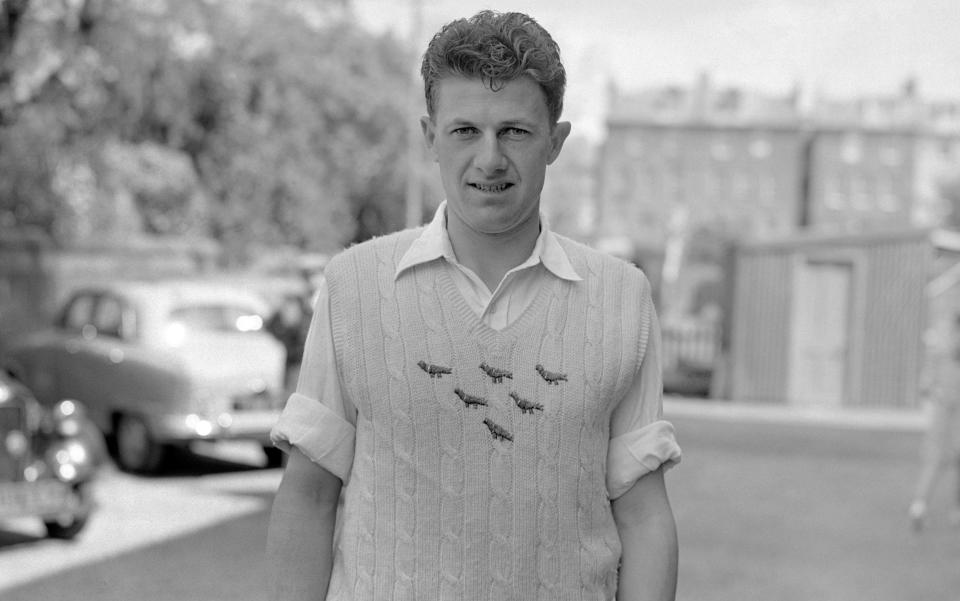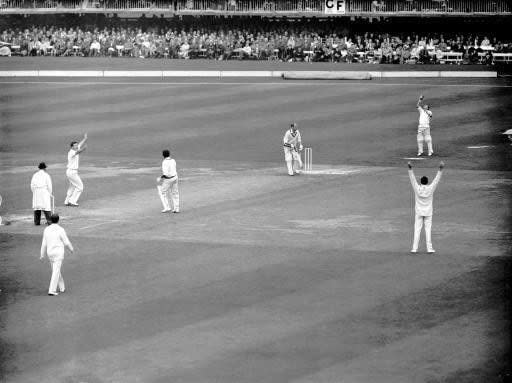Ian Thomson, bowler who became England’s oldest surviving male Test cricketer – obituary

Ian Thomson, who has died aged 92, survived to become England’s oldest male Test cricketer: it is on his bowling for Sussex, however, that his reputation rests.
Rarely quicker than medium-fast, Thomson might have seemed from the square-leg boundary to offer limited threat. He was, however, master of the inswinger, especially when, in favourable conditions, it cut away to the off from the pitch.
He was also tireless and unfailingly accurate. “I remember Denis Compton trying to get after him when Tommy was quite young,” recalled Jim Parks, “and Denis couldn’t. If you stopped Denis going for runs, you’d achieved something.”
Thomson particularly enjoyed bowling at Worthing, where, over 26 matches, he took 129 wickets at an average of 15.29 runs per wicket. At that ground, in 1964, he achieved the best return of his career, with figures of 10 for 49 and five for 26 against Warwickshire. Even so, Sussex lost that contest after being dismissed for 23 in their final innings.
The following match was the last that Sussex played at Worthing. Thomson made the best of the occasion, snapping up eight Nottinghamshire wickets at a cost of only 55 runs.
Thomson’s other notable analyses included eight for 79 against Worcestershire at Hove in 1956, and seven for 12 (including four wickets in eight balls) against Northamptonshire at Peterborough in 1957.
Ultimately, though, Thomson’s most remarkable quality was his unfailing consistency. In each of 12 successive seasons between 1953 and 1964 he took more than 100 wickets. His best year was 1958, when he claimed 133 victims, at only 16.57 apiece.
He also made telling contributions in the first summers of one-day cricket, in particular in the final of the Gillette Cup at Lord’s in 1964. With subtle changes of pace, and prodigious movement in the air, he took four for 23 to set Sussex up for an easy win over Warwickshire. Len Hutton, Alec Bedser and Freddie Brown made him Man of the Match.
“The indefatigable Thomson” was a well-earned epithet. He ended his first-class career of 425 matches (403 for Sussex) with 1,597 wickets (1,527 for Sussex) at a cost of 20.58 runs each. This achievement may be compared to that of his great medium-fast predecessor at Sussex, Maurice Tate, who in 679 matches between 1912 and 1937 claimed 2,783 wickets at 18.16.
It seems strange that such a successful bowler as Thomson should have played in only five Test matches, and those late in his career. Part of the reason, perhaps, lay in his reluctance to blow his own trumpet. Modesty, restraint and good humour were always the essential elements in his character.
He was also unlucky that in the 1950s England possessed a fine set of genuinely fast bowlers in Frank Tyson, Brian Statham, Fred Trueman and Peter Loader. At medium pace Alec Bedser ended his Test career in 1955, and Trevor Bailey in 1959.
Even in the 1960s, however, there seemed to be no enthusiasm for selecting Thomson. Derek Shackleton of Hampshire and Tom Cartwright of Warwickshire, bowlers similar in both pace and achievement, were chosen before him. There was also an emphasis on pace for its own sake. Butch White, David Brown, David Smith and John Price were all preferred to Thomson, albeit with inferior records.
True, in 1956 Thomson had been summoned to replace the injured Michael Cowan of Yorkshire on a tour of Pakistan. He did well but never played in a Test until, aged 35, he was selected to tour South Africa with MJK Smith’s side in 1964-65.
No other bowler had taken as many as 1,497 first-class wickets before appearing in a Test. In South Africa, however, Thomson was chosen for all five matches of the series. Unluckily he found himself toiling on perfect batting wickets against such formidable batsmen as Eddie Barlow, Graham Pollock and Colin Bland.

Statistically Thomson did not impress, finishing the series with but nine wickets at a cost of 63.11 each. Yet he proved admirably economical, conceding runs at only 2.29 per over. Mike Smith was the first to acknowledge that his ability to contain batsmen was crucial to England’s winning the series by one victory to nil.
The effort, though, appeared to have exhausted even Thomson’s rugged physique. In the English season of 1965 he failed for the first time since 1952 to take 100 wickets.
Ian Norman Thomson was born on January 23 1929 in Walsall. His father played football professionally, and his mother, brought up in Sussex, also came from a sporting family.
Shortly after Ian’s birth the family moved to East Ham, then in Essex, where his father owned a garage. At the outbreak of the Second World War Ian was evacuated: he returned, however, in 1943, to attend Forest School in Walthamstow, where he was captain of cricket for two years, and hardly less distinguished as a footballer and boxer.
After National Service with the RAF, Thomson enjoyed some cricketing success with the Ilford team. Essex being uninterested, he followed his mother’s suggestion that he should apply for a trial at Hove. In his second match for Sussex Second XI, in June 1951, he hit an aggressive 107 not out against Surrey Seconds.
Had a promising batsman been discovered? Certainly, Thomson’s performances with the ball did not at first impress. Though he insisted that bowling was his prime talent, in 10 matches for the Sussex Seconds in 1951 he took only five wickets, at 58.80 apiece.
Thomson’s batting was again in the ascendant at the beginning of 1952 when, promoted to the Sussex First XI for a pre-season friendly against Hampshire at Southampton, he raced to another century, 115 not out.
His first-class debut followed, against Northamptonshire, a match in which he failed to distinguish himself. He did, however, establish a notable link with cricket’s golden age. Northamptonshire’s skipper in 1952 was Freddie Brown, who as a young man had played against Wilfrid Rhodes. And Rhodes’s debut, for Yorkshire in 1898, had been against an MCC side captained by W G Grace.
Thomson’s century against Hampshire would prove the last of his career. There would be a few more useful knocks: his highest score in first-class cricket, however, was 77, against Leicestershire in 1959. In his 425 matches (403 for Sussex) between 1952 and 1972 he scored 7,120 runs at an average of 14.74.
As his batting promise dwindled in 1952 he worked increasingly hard on his bowling under the tutelage of Sussex’s captain, James Langridge, and of the county coach, the great Patsy Hendren, who had scored 170 first-class centuries, second only to Jack Hobbs.
Together they helped Thomson to improve his stuttering run-up by establishing a regular 12 paces, while also developing his action at delivery.
In June 1952 he opened Sussex’s bowling for the first time; and that August he twice took five wickets in an innings, first against Middlesex and then against the touring Indians. He finished that season with 45 wickets to his name.
In 1952 Thomson was still officially playing as an amateur. In later life, however, he laughed at the suggestion that he might have been allowed to share the amateurs’ dressing room.
Nevertheless he developed the highest admiration for David Sheppard (later Bishop of Liverpool), who led Sussex to second place in the Championship in 1953. Thomson played an important part in this success, claiming 101 wickets, and winning his county cap in July after returning analyses of four for 28 and five for 27 against Hampshire at Worthing.
Thomson would retire in 1965, perhaps too early. For five years he worked at his father’s garage in Essex, before returning to Sussex. In 1971 he played a few games for the county in the John Player League and the Gillette Cup; and in 1972, aged 43, he turned out in two Championship matches, albeit with scant success.
From September 1972 Thomson taught geography for two years at Brighton College, where the authorities thought it fit to put him in charge of the Under-14 XI. He was then a master for several years at Bevendean Primary School in Brighton.
In 1989, aged 60, he turned out for Alan Oakman’s XI against Derek Underwood’s XI in a match to mark the closure of the Central Ground at Hastings, and demonstrated that his bowling was still in good shape.
He was appointed a vice-president of Sussex CCC. Fittingly, he lived in a flat at Henfield, where cricket has been played since the 1720s.
Jim Parks, aged 89, is now England’s oldest surviving male Test cricketer; the oldest surviving female Test player is Eileen Ash, who is 109.
Ian Thomson married Eileen in 1955; she died in 2015. They had two daughters.
Ian Thomson, born January 23 1929, died August 1 2021

 Yahoo News
Yahoo News 